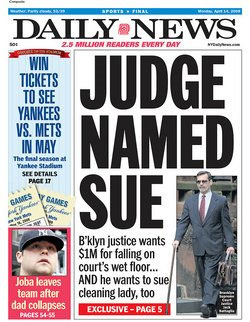@BizJournalism has @jontalton done a piece on biz headlines? I’d like to read that.
— Alex Dalenberg (@alexdalenberg) March 31, 2014
A reader of the most recent post, on writing effective ledes, asked if I would do the same for headlines. Your wish is my desperately needed gift of an idea.
First, my limitations. There are broadly two kinds of people in journalism: reporters and copy editors. The two might be friends or lovers, but never the twain shall meet. Each has different skills, and, critically, different sensibilities. Both are needed for any good news organization. So: I am a reporter/writer personality, not a copy editor.
Headline writing seems simple until one tries it. In fact, doing it well is one of the most difficult skills in journalism. It is made more so by space limitations: Try writing that 30-point hed in a single column.
Sadly, it has been shamefully devalued in recent years as newspapers have been committing suicide and chasing after the latest fad or shiny bauble. Most of the great headline writers have retired or been pushed out — even though the ability to write a great hed is more important than imbedding video in an already too-busy site.
The finest copy desk and group of headline writers I ever knew was at the old Dayton Daily News. The copy desk was fierce, formidable, deeply traditional and, to many reporters, maddening in its ability to pick nits. Except these graybeards and sharp younger editors saved our asses again and again — even as I had to argue with some of them that, yes, “sea change” is an acceptable expression.
But even there, headline writing was an art form reserved for a few. This was especially true of stories appearing on section fronts or sensitive stories. Not every good copy editor was a good hed writer. The slot often changed headlines written by a copy editors. This priesthood would hold sober conclaves before settling on the right hed.
On the other hand, I started out at small papers where you did a little bit of everything. So I learned to write headlines. I learned to count — two spaces for a “W” or “M,” half a space for an “i” or “l.” Yes, I’ve been around that long.
Now I write headlines all the time, for my daily Seattle Times blog posts and for my own commentary on Rogue Columnist. I’ve gotten pretty good, although I could not match skills with the best headline writers with whom my work has been graced. The desk writes the headlines for my Sunday print column. For example, the Times’ Barbara Schechter, a real pro, did a fine job with the headline on this one.
The point is that although the different sensibilities mentioned above are eternal, writers now must become decent headline writers.
The importance of a headline can’t be overstated. Most readers never go beyond it. It can draw them in, scream DON’T READ THIS with its banality, completely misstate the actual story that follows. All of us can tell stories about angry phone calls or emails about “your story.” But a little probing finds that it was about the hed. Readers always assume the story’s author wrote the headline.
If you’re still with me, here my essentials for a good headline:
- Accuracy. It correctly reflects the facts of the story.
- Appeal. It draws the reader in with the use of lively language and, where appropriate, word play, apposition, puns, allusions, etc. This is especially important for business news, which too many believe is “boring.”

- Priority. Especially in a hard news story, it gets at the heart of the heart of the story. What is most important for the reader to see.
- Allure. Don’t give away the whole story. The idea is to make the reader actually stay and read, not skim and move on.
- Economy. Especially with Web sites, headlines can be longer compared with the “old days.” This isn’t always a blessing. Don’t make the reader tunnel through excess word debris, much less think, “Oh, guess I don’t have to read the story now.”
- Tone. This is an important element that comes with experience. When in doubt, ask your colleagues. An investigative takedown must not only avoid a libelous headline, it must have the proper tone. That should be factual rather than sensational. On the other hand, no false equivalency (“UN Issues Dire Climate Warning; Deniers Dismiss It”).
- The promise. Each headline makes a deal with the reader: That it actually connects to the story. So avoid something like “Former Cheerleader’s Beer Fortune Expands” for a story on Cindy McCain and Hensley Beverage Co. “Cheerleader” will get plenty of clicks but…c’mon.

You can find better guides to headline writing than from Homey, here. I am giving you the things that matter most to me. A few last thoughts:
- Don’t use sentences from the story or column as the headline. The headline should add its own value.
- Don’t use the writer’s walkoff (last sentence) as the hed. Nothing is better guaranteed to make a writer homicidal. More to the point, it is lazy and cheats the reader.
- If you are a copy editor or slot, do be willing to discuss a hed with the writer or editor if you are in doubt. This is not giving away your responsibility or power. You are still “the decider,” but be willing to entertain discussion if there’s time.
- Contrary to the purists, not every headline needs a verb. Such dogma results in many boring “is”s. Label heds are especially useful for columns.
- Read newspapers and Web sites with great headlines. Take them apart and figure out what makes them work.
Now go forth and write great headlines.











